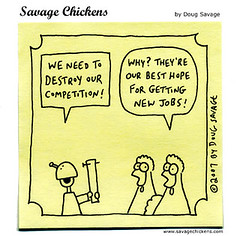
In my meanderings yesterday, I happened across this interesting post on Noah Brier’s blog. Here he mentioned "the strength of weak ties" in relation to social media (and a link to a PDF). I was fascinated immediately by the title and wanted to learn more. Interestingly enough, this must be a promiscuous idea, as I had already written a draft on this exact topic some weeks ago but didn’t realise it until I did a picture search for "granovetter diagrams".
This article by Mark S Granovetter dates back to 1973 and was published by the American Journal of Sociology (vol 78, issue 6). The central idea is that in a social network, the WEAKEST ties are the most powerful in terms of disseminating information. This would seem to be counter-intuitive … surely the strongest links are most important? Apparently not … and this is where it gets interesting!
There is a lot of detail in the article, so I just want to look at a couple of key points. (For more detail take a look at Shiv Singh’s post over at Boxes and Arrows where he applies Granovetter’s ideas to Web 2.0).
First adopters and early adopters
The article points out the difference between FIRST adopters and EARLY adopters. The first adopters are the innovators. They are marginal, isolated, with very small social networks. One of the characteristics of these innovators is that they have one-to-one or "bridge" relationships with people who are part of groups that are at arm’s length. It is also important to note that the bridge is only a "weak tie".
The early adopters by comparison, have a "reputation" to protect … they are not the innovators, but they travel close behind them. This means, for an idea to spread across a social network, there must be a weak link between the FIRST and the EARLY adopter. The most effective FIRST adopters are those that have a number of bridges between themselves and other networks:
Intuitively speaking, this means that whatever is to be diffused can reach a larger number of people, and traverse greater social distance (i.e., path length), when passed through weak ties rather than strong (p 1366).
Weak ties drive action
One of the surprising results of the analysis is the connection between weak ties and action. Based on a study of job seekers, it appears that finding a new role will come not through the strong ties (who you would think would have a vested interest in their friends’ success), but through the extended network of weak ties (in over 80% of cases). What is shown here is that the network of weak ties is more likely to activate a request than someone closer — perhaps the motivation here is to grow that weak tie into something more substantial.
… studies of social and mass communication have shown that people rarely act on mass-media information unless it is also transmitted through personal ties (p 1374).
The community is ABSOLUTELY reliant on the marginalised
But perhaps the most important point is the absolute need for alienation or marginalisation within a community. Again, this seems to me to be counter-intuitive, but the analysis (and more importantly, the testing) bears this out. Without the marginalised or the innovators, ANY community has no possibility for organisation or regeneration: "… strong ties, breeding local cohesion, lead to overall fragmentation" (p 1378). And if you think about it … it does make sense. It is like having a small CONVERSATIONAL gene pool … you need new ideas — otherwise you end up talking about the same thing over and over again.
More reading and ideas
Mark Granovetter also has some interesting thinking in a 1985 article where he identifies economic relations between individuals and businesses within social networks that do not exist in an abstract, idealised market — got to find this one too!






